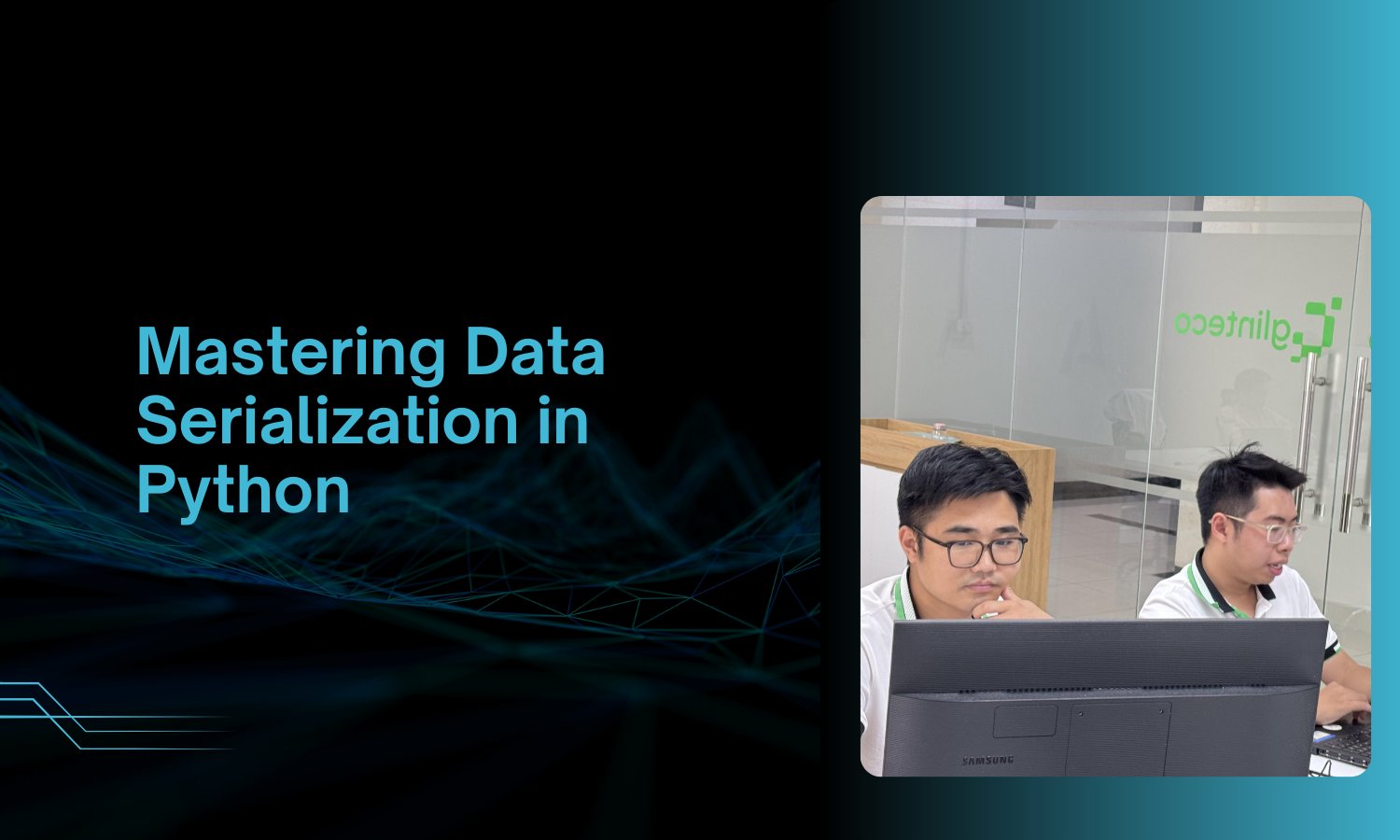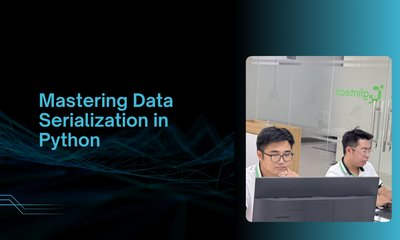Pythonデータシリアライゼーション完全ガイド
By khoanc, at: 2023年12月10日14:01
Estimated Reading Time: __READING_TIME__ minutes


ペタバイトやエクサバイトが標準となっている膨大なデータ処理の世界では、効率的なデータ処理、ストレージ、および伝送が極めて重要になります。データ管理における重要な側面の1つは、シリアライゼーションです。これは、インメモリデータ構造をストレージまたは伝送に適した形式に変換するプロセスです。この包括的なガイドでは、Pythonシリアライゼーションのさまざまな側面を探り、テキストベースとバイナリ形式の両方を網羅します。
1. シリアライゼーションの理解
シリアライゼーションは、元の構造を維持しながらデータの保存、送信、受信を行うための重要な要素です。Pythonは、他の多くの言語と同様に、シリアライゼーションに対する組み込みサポートを提供しており、これは現代のプログラミングにおいて不可欠なツールです。シリアライゼーションの2つの主な目標は、データの永続化と効率的なデータ伝送です。
2. テキストベースのシリアライゼーション形式
2.1: JSONシリアライゼーション
JSON(JavaScript Object Notation)は、データ交換の標準として確立されています。Pythonの組み込みjsonライブラリは、JSONシリアライゼーションを簡素化します。
例:
import json
data = {'name': 'Joe', 'age': 30, 'city': 'Hanoi'}
# シリアライゼーション
json_data = json.dumps(data) # '{"name": "Joe", "age": 30, "city": "Hanoi"}'
# デシリアライゼーション
loaded_data = json.loads(json_data) # {'name': 'Joe', 'age': 30, 'city': 'Hanoi'}
ユニットテスト:
def test_json_serialization():
assert json.loads(json.dumps(data)) == data
長所と短所:
- 長所: 人間が読みやすい、広くサポートされている、使いやすい。
- 短所: 大規模データセットでは、最も省スペースとは限らない。
2.2: YAMLシリアライゼーション
YAML(YAML Ain’t Markup Language)は、JSONの可読性を拡張し、参照などの機能を導入しています。
例:
import yaml
data = {'name': 'Joe', 'age': 30, 'city': 'Hanoi'}
# シリアライゼーション
yaml_data = yaml.dump(data) # 'age: 30\ncity: Hanoi\nname: Joe\n'
# デシリアライゼーション
loaded_data = yaml.load(yaml_data, Loader=yaml.FullLoader) # {'age': 30, 'city': 'Hanoi', 'name': 'Joe'}
ユニットテスト:
def test_yaml_serialization():
assert yaml.load(yaml.dump(data), Loader=yaml.FullLoader) == data
長所と短所:
- 長所: 人間が読みやすい、参照とコメントをサポートする。
- 短所: より複雑、潜在的なセキュリティ上の懸念。
3. バイナリシリアライゼーション形式
3.1: Pickleシリアライゼーション
PickleはPythonのネイティブなシリアライゼーション形式であり、幅広いオブジェクトタイプをサポートしています。
例:
import pickle
book = {'price': 89, 'title': 'python django book', 'published_date': 2022}
# シリアライゼーション
serialized_grades = pickle.dumps(grades) # b'\x80\x04\x95#\x00\x00\x00\x00\x00\x00\x00}\x94(\x8c\x05Alice\x94KY\x8c\x03Bob\x94KH\x8c\x07Charles\x94KWu.'
# デシリアライゼーション
received_grades = pickle.loads(serialized_grades) # {'Alice': 89, 'Bob': 72, 'Charles': 87}
ユニットテスト:
def test_pickle_serialization():
assert pickle.loads(pickle.dumps(grades)) == grades長所と短所:
- 長所: ネイティブサポート、複雑なオブジェクトを処理する。
- 短所: セキュリティ上の懸念、Python固有。
3.2: NumPy配列シリアライゼーション
NumPy配列は、大規模で多次元のデータセットに対して効率的なシリアライゼーションを提供します。
例:
import numpy as np
data_array = np.array([[1, 2, 3, 4], [5, 6, 7, 8]])
# シリアライゼーション
byte_output = data_array.tobytes() # b'\x01\x00\x00\x00\x00\x00\x00\x00\x02\x00\x00\x00\x00\x00\x00\x00\x03\x00\x00\x00\x00\x00\x00\x00\x04\x00\x00\x00\x00\x00\x00\x00\x05\x00\x00\x00\x00\x00\x00\x00\x06\x00\x00\x00\x00\x00\x00\x00\x07\x00\x00\x00\x00\x00\x00\x00\x08\x00\x00\x00\x00\x00\x00\x00'
# デシリアライゼーション
array_format = np.frombuffer(byte_output) # array([4.9e-324, 9.9e-324, 1.5e-323, 2.0e-323, 2.5e-323, 3.0e-323,
3.5e-323, 4.0e-323])
ユニットテスト:
def test_numpy_serialization():
assert np.array_equal(np.frombuffer(data_array.tobytes()), data_array)
長所と短所:
- 長所: 数値データに効率的、大規模データセットをサポートする。
- 短所: バイナリ形式、人間が読み取れない可能性がある。
4. ベストプラクティスと考慮事項
セキュリティに関する考慮事項
- 推奨事項: 信頼できないソースからのデータのデシリアライゼーションには注意してください。
- 例:
ast.literal_evalやサードパーティライブラリなどの安全な方法を使用してください。
バージョン互換性
- 推奨事項: Pythonのバージョンとライブラリの変更に注意してください。
- 例: 長期的なストレージには、バージョン管理または標準化された形式を検討してください。
言語間の通信
- 推奨事項: 複数の言語と互換性のあるシリアライゼーション形式を選択してください。
- 例: 言語間の通信には、JSON、MessagePack、またはProtobufを使用します。
5. 一般的な問題
5.1 セキュリティ上の懸念
信頼できないソースからのデータのデシリアライゼーションは、セキュリティリスクをもたらす可能性があります。悪意のあるシリアライズされたデータは、任意のコードの実行につながり、潜在的に脆弱性を露出させる可能性があります。
アプリケーションがユーザーコマンドラインを受信し、それがシリアライズされると想像してください。アプリはコマンドを抽出して実行します。
import pickle
import subprocess
# 問題: 悪意のあるシリアライズされたデータ
malicious_data = b'\x80\x04\x95\x05\x00\x00\x00\x00\x00\x00\x00}\x94.'
# 問題のあるデシリアライゼーション
try:
commands = pickle.loads(malicious_data)
subprocess.run(commands) # コマンドが「ls -al /home/user/」であると予想
# コマンドが「rm -rf /home/user/」だったら?
except Exception as e:
print(f"セキュリティ問題: {e}")
5.2 ファイルサイズと帯域幅
JSONなどのテキストベースのシリアライゼーション形式は、よりコンパクトなバイナリ形式と比較して、より大きなファイルサイズを生成する可能性があり、ストレージと帯域幅の要件に影響を与えます。
import json
import pickle
import numpy as np
import time
# シリアライゼーションのためのサンプルデータ
data = {'key': 'value'}
numpy_array = np.random.random((1000, 1000))
# 問題: 大規模データセットでのファイルサイズと帯域幅への影響
large_data = {'key': 'value'} * 10**10
# JSONシリアライゼーション - より大きなファイルサイズ
json_start_time = time.time()
json_data = json.dumps(large_data)
print(f"JSONシリアライゼーション時間: {time.time() - json_start_time} 秒")
print(f"JSONシリアライズサイズ: {len(json_data)} バイト")
# Pickleシリアライゼーション - より小さなファイルサイズ
pickle_start_time = time.time()
pickle_data = pickle.dumps(large_data)
print(f"Pickleシリアライゼーション時間: {time.time() - pickle_start_time} 秒")
print(f"Pickleシリアライズサイズ: {len(pickle_data)} バイト")
# Numpyシリアライゼーション - コンパクトなバイナリ形式
numpy_start_time = time.time()
numpy_data = numpy_array.tobytes()
print(f"Numpyシリアライゼーション時間: {time.time() - numpy_start_time} 秒")
print(f"Numpyシリアライズサイズ: {len(numpy_data)} バイト")
5.2 パフォーマンスと効率
特に大規模データセットの場合、シリアライゼーションとデシリアライゼーションのプロセスは計算コストが高く、パフォーマンスに影響を与える可能性があります。
import pickle
import time
# 問題: 大規模データセットでのパフォーマンスへの影響
large_data = {'key': 'value'} * 10**6
# 低速なシリアライゼーション
start_time = time.time()
serialized_data = pickle.dumps(large_data)
print(f"シリアライゼーション時間: {time.time() - start_time} 秒")
6. まとめ
Pythonでのデータシリアライゼーションを習得することで、開発者はさまざまなシナリオで効率的にデータを管理できるようになります。各シリアライゼーションメソッドには長所と短所があり、適切なものを選択するかどうかは、具体的なユースケースによって異なります。シリアライゼーションのニュアンスとベストプラクティスを理解することで、開発者はPythonアプリケーションでのデータのストレージ、伝送、および取得を最適化できます。

![[TIPS] PRO Python debugging](/media/filer_public_thumbnails/filer_public/29/21/29219df0-2a83-4ad5-ac76-2727135e5d86/debug_like_a_pro.png__400x240_q85_crop_subsampling-2_upscale.jpg)
![[Tips] Python DotDict Class](/media/filer_public_thumbnails/filer_public/69/3a/693a38e8-a2b6-4d7a-8479-7905bc93bef5/tips_python_dotdict_class.png__400x240_q85_crop_subsampling-2_upscale.jpg)


